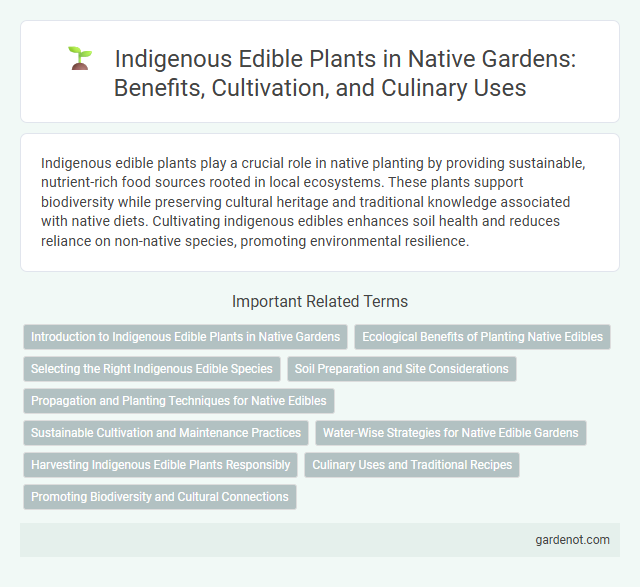Indigenous edible plants play a crucial role in native planting by providing sustainable, nutrient-rich food sources rooted in local ecosystems. These plants support biodiversity while preserving cultural heritage and traditional knowledge associated with native diets. Cultivating indigenous edibles enhances soil health and reduces reliance on non-native species, promoting environmental resilience.
Introduction to Indigenous Edible Plants in Native Gardens
Indigenous edible plants play a vital role in native gardens by preserving cultural heritage and supporting biodiversity. These plants, such as wild berries, Jerusalem artichoke, and squash varieties, provide nutritious food sources while promoting sustainable gardening practices. Incorporating indigenous edibles enhances ecosystem resilience and fosters connections to traditional land stewardship.
Ecological Benefits of Planting Native Edibles
Indigenous edible plants promote biodiversity by providing habitat and food sources for native pollinators, birds, and soil organisms. These plants require less water and fertilizer compared to non-native species, enhancing soil health and reducing environmental stress. Cultivating native edibles supports ecological balance and resilience, contributing to sustainable ecosystems and climate adaptation.
Selecting the Right Indigenous Edible Species
Selecting the right Indigenous edible species involves understanding local ecosystems and traditional uses to ensure successful cultivation and sustainability. Prioritize native plants such as prickly pear cactus, wild strawberries, and elderberries, which thrive in specific regional conditions and offer rich nutritional value. Consulting Indigenous knowledge and ecological databases can guide appropriate species selection tailored to climate, soil type, and cultural significance.
Soil Preparation and Site Considerations
Proper soil preparation and site selection are crucial for successful Indigenous edible native planting, emphasizing loose, well-drained soil rich in organic matter to support deep root growth and nutrient uptake. Selecting a site with adequate sunlight and natural protection from extreme wind or erosion mimics traditional growing environments, ensuring robust plant development. Incorporating local knowledge on soil pH and moisture retention enhances the growth of native edible species such as camas, wild onions, and serviceberries.
Propagation and Planting Techniques for Native Edibles
Propagation of Indigenous edible plants often involves seed stratification or cuttings to mimic natural growth cycles and enhance germination rates. Planting techniques prioritize soil preparation with native compost and strategic placement to optimize sunlight and water access, supporting robust root development. Incorporating traditional knowledge alongside modern horticultural practices ensures sustainable cultivation and preservation of native biodiversity.
Sustainable Cultivation and Maintenance Practices
Indigenous edible plants thrive through sustainable cultivation methods such as polyculture, which enhances biodiversity and soil health while reducing pest outbreaks. Traditional maintenance practices include rotational harvesting and minimal soil disturbance, preserving ecosystem balance and ensuring long-term productivity. Native root systems improve water retention and nutrient cycling, contributing to resilient food systems aligned with Indigenous ecological knowledge.
Water-Wise Strategies for Native Edible Gardens
Indigenous edible gardens thrive by implementing water-wise strategies such as selecting drought-tolerant native plants like wild strawberries and elderberries, which require minimal irrigation. Utilizing mulch and organic ground covers helps retain soil moisture and reduces evaporation, enhancing plant resilience during dry periods. Incorporating rainwater harvesting techniques and efficient drip irrigation systems further optimizes water use while supporting sustainable growth in native edible gardens.
Harvesting Indigenous Edible Plants Responsibly
Harvesting Indigenous edible plants responsibly involves recognizing seasonal growth cycles and sustainable yield limits to preserve native ecosystems. Employing traditional ecological knowledge, such as selective harvesting and rotational gathering, ensures plant populations remain healthy and productive over time. Minimizing disturbance to seed dispersal mechanisms and root systems supports regeneration and biodiversity within Indigenous habitats.
Culinary Uses and Traditional Recipes
Indigenous edible plants hold a vital place in ancestral culinary traditions, offering nutrient-rich ingredients for diverse recipes. Native greens, berries, and roots such as wild leeks, serviceberries, and camas bulbs are commonly incorporated into stews, teas, and baked goods. Preserving these traditional recipes not only supports cultural heritage but also promotes sustainable eating through the use of locally sourced, seasonal ingredients.
Promoting Biodiversity and Cultural Connections
Indigenous edible plants play a crucial role in promoting biodiversity by supporting native ecosystems and enhancing habitat resilience. Cultivating these plants strengthens cultural connections, preserving traditional knowledge and fostering community identity. Emphasizing native planting practices encourages sustainable food systems rooted in ecological balance and heritage conservation.
Indigenous edible Infographic

 gardenot.com
gardenot.com